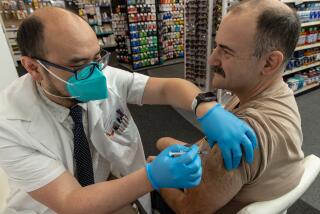Hospitals Face Dire Shortage of Blood
- Share via
Blood shortages, once a seasonal threat, have become year-round crises in many parts of the country, disrupting surgical schedules and forcing hospitals to make precarious treatment decisions.
From New York to California, Minnesota to Florida, the problem is getting worse, with no ready solution.
Because of the dwindling supply in Southern California, doctors at Harbor-UCLA Medical Center in Torrance have delayed two or three nonemergency heart surgeries each week for a month.
Huntington Memorial Hospital in Pasadena has stopped leaving emergency blood supplies in baby delivery wards because they can’t be spared.
And at Cedars-Sinai Medical Center in Los Angeles, officials have discussed whether, in emergencies, they should tap into blood donated by patients for their own surgeries.
Historically, blood shortages are common around major holidays, such as Christmas, Independence Day and Labor Day. The difference now is that supplies have not rebounded, producing the first sustained national blood shortage.
Although no deaths have been attributed to the shortage, hospitals say they can’t rule out such a tragedy if the problem persists.
Experts cite several causes for the blood crisis: the death and failing health of older, reliable donors; increasing restrictions on who may donate; apathy; and cultural and regional differences in giving.
Even with all these pressures on the supply side, blood donation has increased in past years. The trouble is, demand is swelling, too, because new life-saving technologies are using more blood.
“We’re as short as we’ve ever been for as long as we’ve ever been,” said Dr. Harvey Klein, president of the American Assn. of Blood Banks and chief of transfusion medicine at the National Institutes of Health.
Cities such as Milwaukee and Minneapolis, which have long collected more blood than their residents need, are curtailing exports to the rest of the nation.
The shortage could get worse this fall, when the American Red Cross imposes additional restrictions to protect the public from a human form of mad cow disease.
Beginning in September, the Red Cross plans to turn away people who have spent at least three months in the United Kingdom or six months in Europe since 1980. The Red Cross, which manages nearly half the nation’s blood supply, says its new rule could exclude up to 8% of all donors.
The U.S. Food and Drug Administration is considering similar, but less restrictive, rules for all blood banks. Supporters say the changes will help assure the safety of the blood supply.
Critics counter that patients in dire need of blood will suffer and even die.
“I’m very, very scared that there’s going to be patients dying due to the unavailability of blood,” said Dr. Michael Busch of the Blood Centers of the Pacific in San Francisco. “I do not believe this is crying wolf.”
The blood shortage compounds other persistent problems in health care, especially the national nursing shortage. Patients in some places have waited a month or more for nonemergency surgeries because hospitals can’t find enough nurses. Now, blood shortages add to the delays.
“We just coincidentally have two crises at the same time,” said Dr. Scott Karlan, a general surgeon and president-elect of the Los Angeles County Medical Society.
Karlan said messages are regularly blared in the corridors of Cedars-Sinai, asking employees to donate blood.
“Please come to donate blood,” the messages say. “We’ve run out again.”
Blood centers admit they have done a poor job of collecting data showing the extent of the problem, and the federal government keeps no such figures. But experts find some indicators disturbing.
Typically, dips in summer donations force the New York Blood Center to cut back on daily shipments in July. This year, low supplies forced curtailed shipments beginning in May. To date, supplies are not back to normal.
“The shortages are starting earlier and cutting deeper,” said Linda Levi, a spokeswoman for the blood center. “At least in our community, we do not have enough donors. And the donors we have do not donate with enough frequency.”
New York officials say they would lose one-third of their blood supply if the mad-cow restrictions were imposed by the federal government. Included in that are about 140,000 pints of blood imported from European countries, which represent 25% of New York’s supply.
Blood bank officials are working with the federal government to make up for the loss, perhaps with donations from military personnel overseas.
Southland Imports 44% of Its Blood
In Southern California, the Red Cross imports 44% of its blood from other regions, mostly Portland, Ore., and Boise, Idaho. In the fiscal year that ended in June, the agency imported more than 191,000 pints of blood. That compares with about 182,000 pints the year before.
Because of the national shortage, the local branch expects to import only 178,000 units this year and will struggle to make up the difference by increasing marketing and company blood drives.
Still, on a recent day, the shelves at the Red Cross blood center near downtown Los Angeles were almost bare. The cooled storage bins contained only a few plastic bags.
Nationally in 1999, blood donations increased 10.7% while demand shot up 8.3%, according to the National Blood Data Resource Center. No more recent data are available.
But demand at any given time often outstrips supply. One reason is that red blood can be stored only 42 days--and blood platelets that help clotting last a mere five days.
In addition, a unit of type A blood is of no use to a person with type B. So excess supplies of one cannot relieve high demand for another.
Blood bank officials fear that people will confuse this crisis with familiar seasonal pleas. The public may write this off as “just another sniffling appeal for blood,” said Dr. Janice Nelson, blood bank director at Los Angeles County-USC Medical Center.
In any case, reliable donors are becoming scarcer. The World War II generation, the group with the highest donation rate, is dying away. And with it is the sense of duty that once filled blood centers with eager donors.
About 60% of Americans are eligible to give blood, but only 5% of that group donates.
Cultural factors also come into play. The generous Midwestern mind-set, some say, favors donation. That is one reason coastal metropolises import so much blood from the nation’s center.
“If the media says we have a shortage, our hotlines start lighting up, sometimes within hours,” said Rod Gnerlich, spokesman for the Blood Center of Southeastern Wisconsin.
“Milwaukee and Wisconsin are very altruistic areas. It’s a very neighborly type atmosphere.”
Los Angeles-area blood officials say the urban sprawl and dizzying diversity make for a donor pool that is less responsive.
Most troubling here is the severe lack of Type O. O negative is the most sought-after type because it can be given to people of any blood type in an emergency. Because O is the most common type among Latinos, it is even more desirable to have such reserves in Southern California. Despite growth in the Latino and other minority communities, blood industry officials admit that they are not doing enough to attract minority donors.
One obstacle is that some Latinos are wary of the medical community because they fear deportation or jeopardizing their citizenship status.
The shortage has been mitigated somewhat by advances in so-called bloodless surgery, in which surgeons recapture blood lost during operations.
The drain on the blood supply has been lessened, as well, by donations by patients and their relatives for use in upcoming operations.
This reserve blood supply comes with its share of ethical questions, though. In an emergency, for example, can a hospital draw upon those designated blood supplies and use them for other patients? Or should it leave blood units for their owners and let other critically ill patients die?
Doctors and blood bank officials at Cedars-Sinai have discussed this quandary, though they haven’t been forced to make the choice.
“We would consider utilizing those [designated] units for patients in urgent need,” said Dr. Ellen Klapper, co-director of Cedars-Sinai’s blood bank. “It’s not something that’s Plan A or Plan B, but Plan D.”
Shortage Requires Tough Decisions
Other crises have been narrowly averted. Last week, Dr. Achilles Demetriou, Cedars-Sinai’s surgery chairman, had to approve a liver transplant, knowing that afternoon surgeries would have to be canceled if too much blood was used. He was relieved that that didn’t happen.
For several weeks, supplies have run so low that the Cedars-Sinai blood bank has had to sign off before any major surgery.
“We are operating on the edge,” Demetriou said. “A lot of people have to spend a lot of time--hours--trying to make sure nothing goes wrong. And at the end of the day, everybody breathes a sigh of relief that we got through another day.
“It’s changing everything,” he added. “It’s changing the way that we manage the operating rooms and schedules.”
At Harbor-UCLA Medical Center, officials have delayed heart-valve and bypass operations for patients with chronic conditions who are stable. One patient’s surgery was postponed twice, said Dr. Gail Anderson Jr., the hospital’s medical director.
Even with those delays, supplies remain dangerously low. Harbor had nine units of O negative blood midday Thursday, compared with the usual reserve of 80 units.
Los Angeles County-USC Medical Center had 25 to 30 units of O negative blood, compared with the typical reserve of 150, said Anderson, acting chief medical officer of county health services.
One operation could wipe out the supply, Anderson said.
Harbor has sent a reminder to all doctors encouraging them to collect, filter and reinfuse blood--from a stabbing or shooting victim, for instance, who may have excess blood in his chest. That’s a clinically accepted practice, Anderson said.
These patchwork solutions don’t suffice, said Dr. Arthur Caplan, chairman of a federal advisory panel on the blood supply.
“We need to have a sustained organized national crisis mode response to increase donations,” said Caplan, also a bioethicist at the University of Pennsylvania. “It’s not enough to simply say we’re going to work on it.”
(BEGIN TEXT OF INFOBOX / INFOGRAPHIC)
Giving Blood
In order to donate blood, a person must meet certain criteria, including:
* Being older than 17.
* Weighing at least 110 pounds.
* Being in good health.
Potential donors are permanently disqualified if they:
* Have had hepatitis after age 11.
* Have ever received chemotherapy treatments for cancer.
* Have used injectable street drugs, including steroids, even once.
* Are men who have had sex, even once, with other men, even protected.
* Have HIV or AIDS.
Appointments can be made by calling (800) GIVE-LIFE, or (800) 879-4484 in Riverside and San Bernardino counties.
Source: American Red Cross
More to Read
Sign up for Essential California
The most important California stories and recommendations in your inbox every morning.
You may occasionally receive promotional content from the Los Angeles Times.










